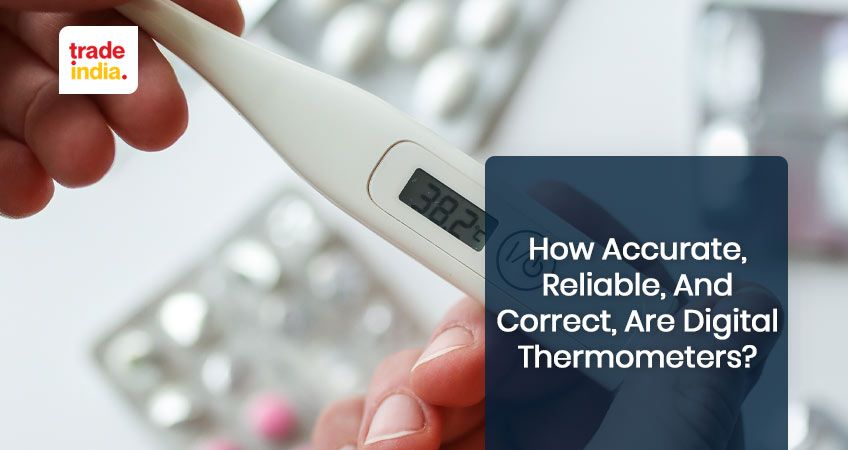
Introduction
It is a big blessing to have a medical thermometer at home that is both reliable and easy to read for anyone who needs to use it. After all, a good thermometer can detect instantly and with accuracy if someone is running a fever, thus aiding him or her in taking precautionary or curative measures. Post-COVID, the sales of digital thermometers have grown manifold alongside digital oximeters. Digital thermometers provide an edge over traditional mercury-based thermometers since the latter is far easier to read, offers much quicker temperature measurements, and hugely reduces incorrect temperature readings. They are slightly more expensive than traditional clinical thermometers, but the advantages they provide more than makeup for the additional cost.
What is a digital thermometer?
A digital thermometer is an electronic device that is used to determine body temperature or temperature gradient using heat sensors. The temperature reading is displayed digitally on a digital screen usually on the body of the thermometer. Digital thermometers can usually present accurate temperature readings within a minute. They can be used orally, rectally, or even in the armpit area. Besides the generic digital clinical thermometer, there are other types of electronic thermometers such as:
1. Tympanic Thermometers
Tympanic thermometers, also known as ear thermometers, use a probe that goes into the ear canal to read the temperature. Not only are tympanic thermometers much more expensive than digital thermometers, but they also call for a clinical approach to handling them and taking readings. Even a wrong angle of inserting the probe in the ear can cause an erroneous reading.
2. Infrared Thermometers
In vast contrast to any other type of thermometer, infrared thermometers are totally contactless. This is achieved by using an infrared scanner instead of a probe to scan body temperature. Infrared thermometers usually measure body temperature around the forehead, but they can be inaccurate.
Temperature Readings With A Digital Thermometer
There are three different ways to take temperature readings with a digital thermometer-
1. Oral Readings
In this procedure, body temperature readings are taken by inserting the tip or probe into the mouth in the area under the tongue and holding the probe in place by tightly closing the mouth. This is the more common method of taking temperature readings using a digital thermometer.
2. Armpit Readings
In this process, the tip of the thermometer is applied to the armpit area with the armpit tightly pressed against the torso to hold the thermometer in place. Armpit readings are also known as axillary readings. They are slightly lesser accurate than oral and rectal readings.
3. Rectal Readings
Rectal readings are taken by inserting the probe of the thermometer into the rectal cavity. Rectal readings are the most accurate. While taking armpit readings, it is important to bear in mind that an axillary temperature reading in the human body is typically 0.5°F to 1°F lower than an oral temperature reading. On the other hand, rectal temperature readings are typically 0.5°F to 1°F higher than oral temperature readings.
Also Read: How To Start Digital Thermometer Business?
The Precision of A Digital Thermometer
Ans. During extensive tests conducted circa 2005 by Ratchada Kitsommart and Sopida Phatthanasiriwetin to measure the precision of digital thermometers in a Neonatal environment, it was found that the digital thermometers were 86% accurate in the case of rectal readings. When it came to axillary temperature measurements, the accuracy of the same dropped to 75%. However, digital thermometer technology has progressed by leaps and bounds in the two decades since the tests and in the present day, we have far more accurate digital thermometers. Current digital thermometers of reputed brands have an accuracy of ±0.01°C.
Most Accurate Digital Thermometer
Ans. Since rectal digital thermometers measure the core body temperature or temperature gradient, they are generally considered to be the most accurate among all digital thermometers. Since it is not convenient for everyone to use rectal thermometers, oral and axillary (armpit use) thermometers are more widely used.
Digital Thermometers vs Traditional Thermometers
In short, yes. There are several parameters in which digital thermometers have outclassed traditional mercury thermometers.
Traditional mercury-based clinical thermometers are not only far more difficult to read than their digital counterparts, but they rely on calibrations that have been etched onto the stem of the thermometer. As such, such thermometers have a low number of significant digits, i.e., it is very difficult to take readings in decimals. On the other hand, digital thermometers have a 10x better resolution since they allow readings of up to a tenth of a degree in both centigrade and Fahrenheit.
Secondly, digital thermometers provide much faster results compared to their mercury thermometer counterparts. You might remember having an old mercury thermometer pressed under your armpits for a minute or two whenever you caught a fever in your childhood. This was because the mercury took very long to heat and rise. On a digital thermometer, there is no mercury. Instead, there is a heat sensor that instantly displays your body temperature. So, no more waiting while sitting still!
Digital thermometers are also far safer to have around the house than mercury thermometers. As the name suggests, a mercury thermometer is a glass apparatus filled with mercury – a highly toxic substance that, if exposed to the skin (on breakage of the glass), will cause serious health complications. If ingested, mercury is fatal, even in small amounts. Thus, extra precaution has to be taken to keep mercury thermometers out of the reach of children. Digital thermometers, on the other hand, do not contain mercury or other harmful substances and are thus, safer. Lastly, in the case of the mercury thermometer, the broken glass itself provides a high risk of injury. Digital thermometers have a plastic body and are far safer.
However, all the above being said, digital thermometers have been known to be far more prone to showing fluctuations in body temperature readings than their mercury counterparts. So, precautions should be taken to ensure that readings are as accurate as possible.
FAQs: Digital Thermometers
Q. Is it possible to use my smartphone as a thermometer?
Ans. There are several apps available for smartphones that claim to be able to measure your body temperature. These apps usually utilize the temperature sensor on your smartphone or its fingerprint scanner to “read” your body temperature. However, there’s a big catch in using such apps — the smartphone already has an internal temperature of its own, and that directly interferes with the temperature sensor, increasing the possibility of erroneous readings. Also, for such apps to be effective, the phone must be allowed to cool down for you to get a near-accurate temperature reading. So, while technically smartphones can be used to measure body temperature, they should only be used as a last resort, and that too while following the correct procedure.
Q. Why do my digital thermometer readings differ?
Ans. There are several factors that influence the body temperature reading that your digital thermometer provides you. It could be that the thermometer was in a hotter or colder room before and you did not bring it to the same ambient temperature as the room you are now taking your measurements in. It could also be that your room temperature is outside the normal operating range of your digital thermometer (10 °C - 40 °C). If you are using a rectal thermometer, variations in either the depth or the angle of insertion of the thermometer probe can throw different readings. Lastly, it is considered normal for your body temperature to actually vary during the day. For example, your body temperature usually runs lower in the mornings than in the evenings, so there is bound to be a difference in readings even when the digital thermometer is perfectly calibrated. However, as a rule, body temperatures should not vary by more than 0.5 °C throughout the day.
Q. How much do digital thermometers cost?
Ans. Digital thermometers are relatively inexpensive. A digital thermometer from a reputed brand such as Omron or Hicks can be purchased for less than five hundred rupees. On the other hand, infrared forehead thermometers (for instance the ones used at security checks in malls, airports, and hospitals) cost significantly more. The cheapest digital infrared thermometer will set you back by at least a thousand rupees.
When shopping for a digital thermometer (or any other clinical device for that matter), it is advisable to go for brands that are known to be high quality. A cheap digital thermometer from an unknown brand might offer the same features as its more expensive branded counterpart. But there is a much higher chance of getting erroneous readings with these thermometers. Even an error of 1 or 2 degrees can be the difference between life and death.
Q. Where to buy digital thermometers?
Ans. Digital thermometers are available both online as well as in traditional brick-and-mortar establishments. Buying digital thermometers online via an e-commerce website or a phone app provides a slight edge to the buyer as it allows them to conveniently place various brands and models side by side to compare prices, features, and warranty information. Online e-commerce websites also provide customer reviews and ratings of the product which might make it easier for you to choose a product that best suits your requirements. Moreover, when you shop online, you have access to any product available in the market from the comfort of your home.
Related Blog Topics:





